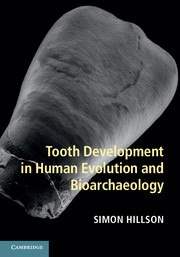Book contents
- Frontmatter
- Contents
- Acknowledgements
- 1 Why development and why teeth?
- 2 Development schedule, body size and brain size
- 3 How teeth grow in living primates
- 4 Microscopic markers of growth in dental tissues
- 5 Building dental development sequences
- 6 Human evolution, pace of development and life history
- 7 Dental markers of disease and malnutrition
- 8 Health, stress and evolution: case studies in bioarchaeology and palaeoanthropology
- 9 Conclusions
- Appendix A Tables
- Appendix B Technical information
- References
- Index
2 - Development schedule, body size and brain size
Published online by Cambridge University Press: 05 June 2014
- Frontmatter
- Contents
- Acknowledgements
- 1 Why development and why teeth?
- 2 Development schedule, body size and brain size
- 3 How teeth grow in living primates
- 4 Microscopic markers of growth in dental tissues
- 5 Building dental development sequences
- 6 Human evolution, pace of development and life history
- 7 Dental markers of disease and malnutrition
- 8 Health, stress and evolution: case studies in bioarchaeology and palaeoanthropology
- 9 Conclusions
- Appendix A Tables
- Appendix B Technical information
- References
- Index
Summary
In comparison with other primates, the sequence of human development lasts a long time and has an unusual pattern of peaks in growth rate. But is it unique? Long development might be a function of size and humans are among the largest of primates. Similarly, development patterns vary between primates and it could be that humans form part of a continuum in the sequence of growth stages. Then there is the large human brain. Do humans follow a unique growth trajectory to achieve it?
How development is studied
Development is studied by measuring growing individuals at different ages. The study may be cross-sectional, with just one examination per individual in a group which includes a variety of ages, or longitudinal, with several examinations at different ages for each individual. The measurements taken vary. Some relate to general body size. In humans this is usually stature, but in young children the equivalent is supine length, where the child lies on its back between parallel head and foot boards. There are two alternatives for measuring body size in a foetus or young baby. Crown-rump length, from the top of the head to the most prominent part of the buttocks, is approximately equivalent to sitting or trunk height in older children and adults. Crown-heel length is measured with the baby lying on its back and one leg stretched out, and is the nearest equivalent to stature. The upright bipedal stance of the human body makes it difficult to find directly comparable stature measurements for non-human primates. For them, crown-rump length (trunk length) is commonly measured, along with lengths of segments of the limbs. Simpler than any of these, however, is to measure body mass (or weight in everyday language). This represents all the different systems and tissues of the body and shows different patterns of growth from stature, which reflects largely the size of the skeleton.
- Type
- Chapter
- Information
- Publisher: Cambridge University PressPrint publication year: 2014

